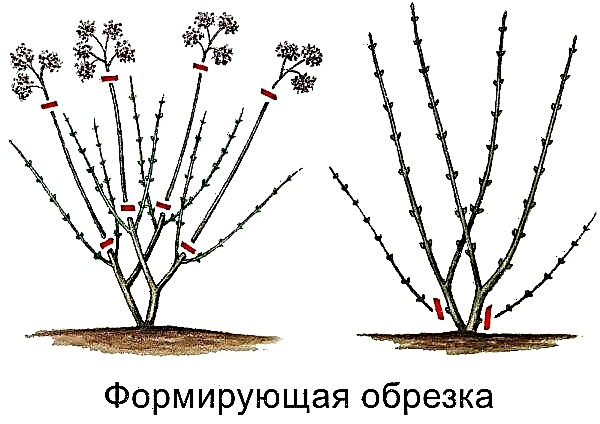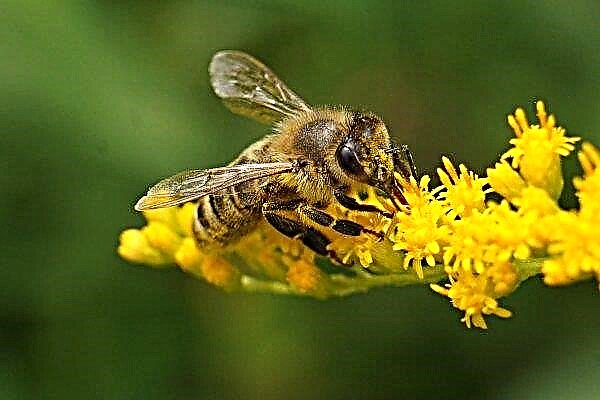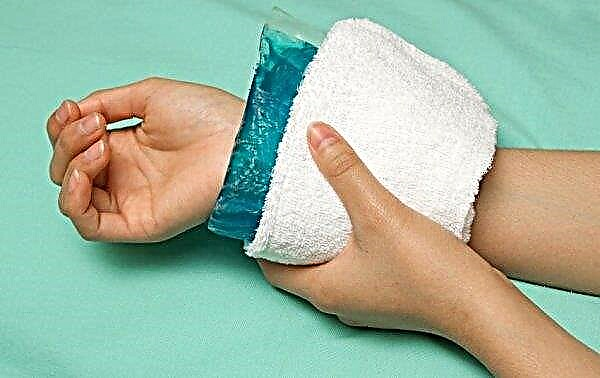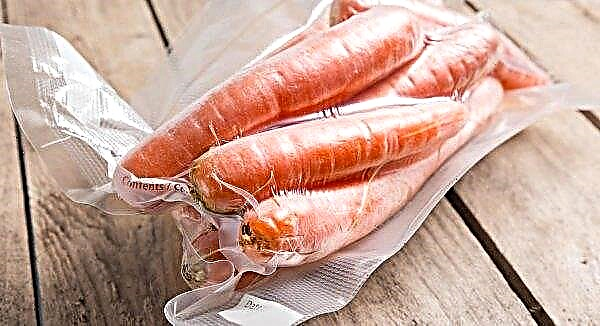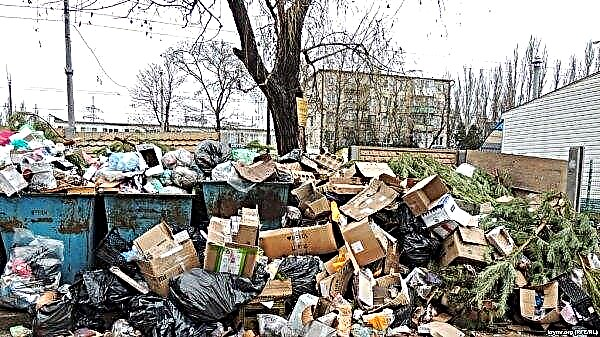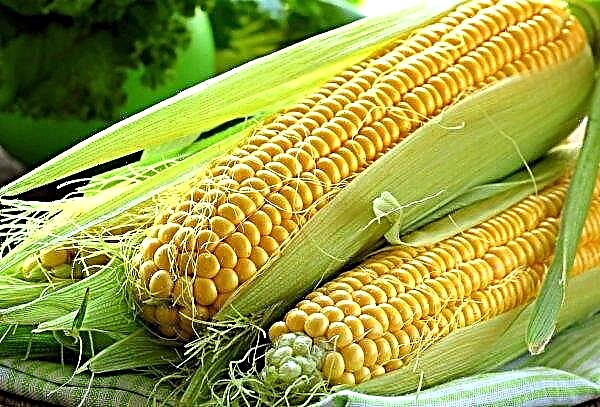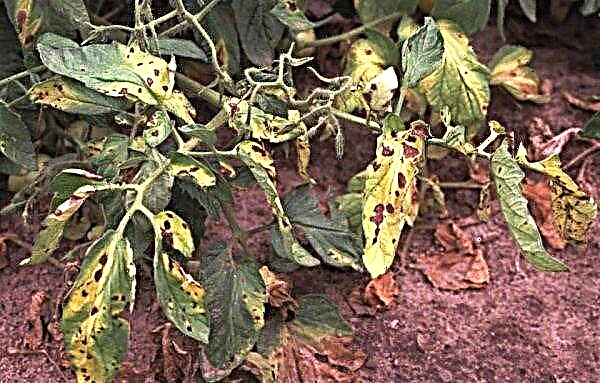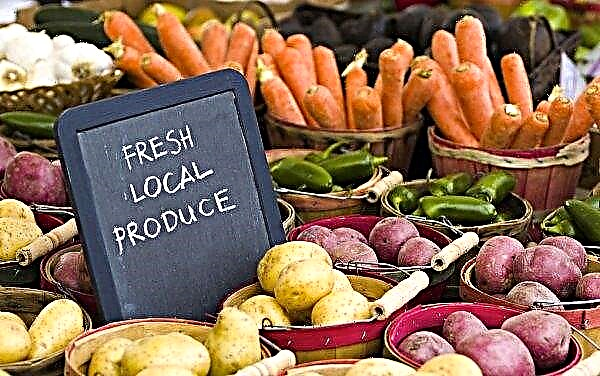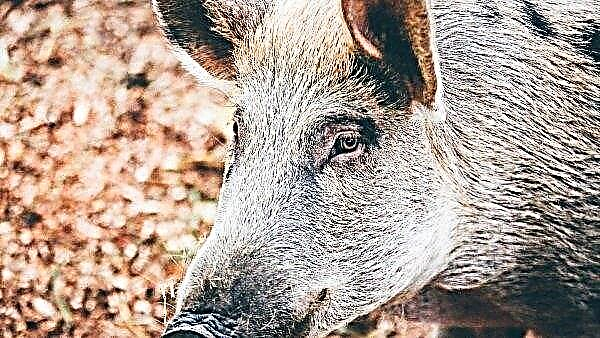Many gardeners tend to grow white cabbage in a personal plot, because this plant is considered the “second bread” and is one of the first places among vegetable crops in terms of popularity of consumption and distribution. The article will introduce the characteristics, advantages and agricultural technology of the cabbage variety Dobrovodskaya F1.
History of Variety Breeding
The merit in the selection of varieties belongs to Czech specialists. The hybrid was bred in 1956, is still popular and grown in vegetable gardens. The seed producer is the vegetable company Moravosid (Moravoseed, Czech Republic). The cost of packing seeds (16 pieces) is about 27 rubles. According to gardeners, seed germination is 100%, but if agricultural technology is not followed, then not all seedlings can grow to full maturity.
Description and characteristic
The variety of medium-late white cabbage Dobrovodskaya F1 is a first-generation hybrid, as evidenced by the F1 code in the designation.
The culture is perfectly adapted for cultivation in climatic conditions of the regions of the middle and southern strip and gives large yields (12-14 kg / m²) on almost any soil, and on fertilized and fertile soils, productivity increases.
Appearance of cabbage
The bush is upright, low, medium in size, with abundant spreading leaf mass, which requires a large cultivation area. The rosette is elevated, sits on an elongated stem - the outer stalk - 15–20 cm high. Rosette leaves are dark green, wavy along the edges, with a natural wax coating and large veins. Covering leaves of a head of cabbage - light green.
Did you know? So that the cabbages grow large, in Prussia the earth was compacted under cabbage and a large stone was laid nearby.
The root system is strong, well-branched on the surface and to a depth of 40 cm, fibrous in the seedling method of cultivation and the core in seed. Heads are large, even, with a cut, they are dense, white inside, voids are absent. Weight can reach 6–8.5 kg, but larger specimens are also possible - up to 10 kg in conditions of fertile soil and irrigation. The inner leaves are white, succulent, with a sweet taste, the stalk is medium.

Ripening time
This is a medium-late variety - 135-155 days pass from planting seedlings on a bed to ripening. This means that after 3-4 months you can harvest. The head of cabbage is formed 2–2.5 months.
Frost resistance
The variety is considered cold-resistant, but not suitable for cultivation in the northern regions due to the short summer and long growing season of the culture.
Positive qualities and disadvantages of the variety
- Pros of Dobrovod cabbage:
- high-yielding variety with simultaneous ripening;
- juiciness of leaves and sweetish taste;
- genetic resistance to pathogens;
- dense heads of cabbage do not crack and are not afraid of transportation.
The disadvantages of the hybrid include demanding soil fertility and abundant watering, as well as low storability.
Agriculture cultivating varieties
To get a good harvest of cabbage, you need to know the agricultural technology and the features of caring for this crop:
- the need for irrigation - moderate in the seedling period, increases when heading out;
- Long daylight culture
- crop rotation must be observed.
Soaking seeds for sowing
Cabbage seeds need pre-sowing preparation, which promotes friendly germination, the growth of healthy seedlings and an increase in yield by 20%.

Such training includes:
- heating seeds on a heating battery (1 day) or treatment with hot water (+ 50 ° C, 15 minutes);
- disinfection (increases resistance to harmful lesions) - soaking for half an hour in a pale solution of potassium permanganate, infusion of chamomile, oak bark or in aloe juice with further washing;
- processing with special solutions of the growth regulator - soaking for 12 hours in Zircon, Albite, Energen, Epine, nitrophos (5 g per 1 liter of water).
Important! Seeds of different types and varieties of cabbage, as well as seeds of rapeseed, mustard and turnip, do not differ in appearance. Crops can be distinguished only by seedlings. Therefore, it is important to buy planting stock indicating varieties in specialized stores.
Further seedling care
Seeds that have been processed are sown to obtain seedlings in March or early April:
- in seedlings trays with continuous or horizontal sowing with further picking of sprouts in the cotyledon phase;
- in separate cups - 2-3 pieces with further rejection of weak shoots.
The depth of sowing seeds is 1.5 cm. Before emergence, you need to keep the trays at a temperature of + 18 ... + 20 ° C, covering them with a film. Germination light is optional. The first loops of sprouts appear on the 4th day and unfold the cotyledons.

In this case, the roots reach 12–15 cm, and the lateral roots begin to form. A week later, the first real sheet appears. Between the formation of each subsequent sheet, a week passes. According to these indicators, you can determine the time of planting seedlings in the ground.
For the normal development of seedlings, temperature and light conditions are very important:
- In the first days after germination - + 7 ... + 10 ° C, to exclude stretching seedlings.
- 1 week after germination - + 15 ... + 18 ° C. During this period, you can dive.
- Good daily illumination - for 16 hours. If necessary, lighting with phytolamps will be required.
Important! If the necessary conditions cannot be created in the apartment, then you can sow seeds for seedlings directly on the site, choosing the warmest place and constructing a temporary film greenhouse.
In order for the seedlings to be squat and strong, and the roots to develop faster and grow lateral roots, the seedlings are picked in separate cassettes according to the 3 × 3 cm pattern, deepened to cotyledon leaves.

Growing seedlings require regular watering and spraying, but can not stand waterlogging. It must be ensured that the earthen lump is always hydrated and does not dry out. And in order to avoid decay of the roots and stems, the soil must often be loosened, and seedlings should be provided with good drainage.
It is advisable to feed the seedlings three times before transplanting into the soil with prepared mineral fertilizers (Kemira Lux) or with a solution prepared personally using one liter of water.
Check out

The composition of the solution:
- ammonium nitrate - 2 g;
- potassium nitrate or potassium chloride - 2 g;
- superphosphate - 4 g.
The first top dressing is needed 1 week after a dive. The second and third introduction of nutrients is carried out with an interval of 2 weeks. The dose of potash fertilizers in the third top dressing (it is called quenching) is increased to 8 g for better adaptation of seedlings in the open ground.
It is also worth carrying out foliar top dressing by spraying plants with solutions of the preparations "Kemira", "Agricola". 2 weeks before transplanting seedlings into open soil, it is necessary to begin hardening by lowering the temperature to + 6 ... + 8 ° С. The seedlings are carried out first for several hours into the air and gradually increase the hardening time to 1 day.

Preparation of the place and soil on the bed
The cabbage plot should be flat and sunny. It is better to prepare it in the fall, then in the hot sowing season in the spring you will not have to waste time. The bed is dug up to a depth of 25-30 cm, organic fertilizers are added.
In spring, the area should be leveled, a mixture of mineral fertilizers (per 1 m²) should be added and watered:
- superphosphate or nitrophoska - 50 g;
- wood ash 200 g;
- urea - 10 g.
Important! The causative agent of a fungal infection called keel remains viable for 7 years.
If stagnation of melt or rain water is possible on the site, the beds should be raised and ridges formed. It is necessary to observe crop rotation and not to plant cabbage in the same place for 4 years due to possible depletion of the soil, the accumulation of pests and pathogens.
 The best place for medium-late cabbage will be places where cucumbers, early potatoes, carrots, pumpkin and legumes grew. Avoid places where beets and cruciferous vegetables grew.
The best place for medium-late cabbage will be places where cucumbers, early potatoes, carrots, pumpkin and legumes grew. Avoid places where beets and cruciferous vegetables grew.
Transplanting seedlings in the open ground
Seedlings are planted in May-June at the age of 50–55 days with 4-5 true leaves unfolding. The soil should warm up to + 7 ... + 12 ° С. For each bush in the hole, you can add 1 bucket of compost.
Did you know? Everyone knows the Pythagorean theorem, but not everyone knows that the famous mathematician appreciated cabbage for its medicinal properties and was engaged in its selection. And the Roman emperor Diocletian abandoned the throne and began to grow cabbage.
Seedlings are planted in moist soil. Planting scheme - 60 × 50 cm, density - 2-3 bushes per 1 m². The elongated seedlings can be slightly deepened to the lower leaves. Squat and strong shoots are best not to be deepened to protect the lower leaves from decay in the cool and wet period.

Young seedlings can suffer from the hot sun, so planting in the early days should be shaded with branches of deciduous trees or woven material. You can cover each bush for the first time with an inverted bucket or a cut plastic bottle. Salad is sown on an empty seat or cabbage seedlings are additionally planted for substitution in case of the death of any sprouts.
Features cabbage care
The best indicators of yield and product quality are observed if the plant receives the necessary complete care.
Watering and feeding
In order to grow heads of cabbage weighing 10 kg, you need a lot of nutrients. With a lack of mineral fertilizers, plant growth slows down, and heads of cabbage are poorly tied and grow small.
Fertilizer rates should take into account the stages of crop development, soil structure and its fertility. A minimum of 3 top dressings should be carried out per season. The first top dressing in the seedling phase is carried out 10 days after planting.
Can be used:
- organic matter per 1 m² - 3 kg of mature humus or 2 kg of bird droppings.
- 0.5 kg of cow manure or bird droppings per 1 bucket of water with a flow rate of 500 ml for each bush;
- potash fertilizers and superphosphate (20 g each) with the addition of urea (10 g) per 1 bucket of water;
- solution of humic fertilizer "Life force: Vegetable abundance", "Agricola 1", "Kalyfos N".
 Further dressing is done at intervals of 2 weeks. The second feeding is carried out with an increase in leaf mass, nitrogen is important in the composition of fertilizers. The composition of nutrient mixtures and consumption rates are the same. The third feeding is in the phase of head formation.
Further dressing is done at intervals of 2 weeks. The second feeding is carried out with an increase in leaf mass, nitrogen is important in the composition of fertilizers. The composition of nutrient mixtures and consumption rates are the same. The third feeding is in the phase of head formation.
In this case, phosphorus and potassium fertilizers (monophosphate or potassium nitrate, nitrophoska) are necessary. In the future, with weak growth, it is fertilized 1-2 times with a solution of nitrogen and potassium fertilizers. For this, dry mineral fertilizers are mixed with irrigation water and combined with shallow loosening.
The variety needs frequent and plentiful watering. Every 3 days, depending on weather conditions, drip irrigation or sprinkling is performed with a flow rate of 3 liters of water per bush.
Check out more

It is good to water it with rain water, if its collection is organized.
Before harvesting cabbage, watering is reduced, and 1 month before harvesting, it is completely stopped to prevent cracking of heads.
Loosening and weeding
Loosening the soil can improve the moisture and air permeability of the soil. It should be carried out after rain or watering, so that the soil is not covered with a crust, which makes it difficult for nutrients to reach the roots.
The first loosening (deeper, 7-10 cm) is done during the period of active growth of weeds - 10 days after transplanting. Then the depth is reduced to 3-5 cm, so as not to damage the surface roots. Aisles loosen to a depth of 8-10 cm.

Loosening is combined with weeding, removing weeds from the beds, which take nutrients from the cabbage (up to 30%), obscure the plantings and create favorable conditions for the spread of harmful lesions.
Hilling bushes
Together with loosening during the growth of cabbage, the hills are cultivated in order to form additional lateral roots, improve nutrition and ensure plant resistance to lodging and tipping, which is possible with an increase in the weight of the head. In addition, pests will not be able to lay eggs near the roots.

Timely hilling can provide a 10% increase in yield. The event is carried out in a radius of 25 cm from the root, adding 30 cm to the ground. After earthing up, row spacing can be mulled, which will make it possible to reduce the frequency and volume of irrigation.
Pest and Disease Control
The cabbage variety Dobrovodskaya is immune to pathogenic infections: fusarium, black and dry rot, black stalk, fomosis and bacteriosis, is not affected by cruciferous fleas, but gets sick with keel under adverse conditions and disturbed agricultural practices
The keel most often develops on acidic soils, therefore, if necessary, liming (per 1 m²) with dolomite flour (800 g) or ash (250 g) should be carried out. This fungus does not like nightshade and onion crops and dies in such plantings in 3-4 years. In case of damage, it is necessary to spray the bushes with colloidal salt (10 g per 1 bucket of water) or apply the fungicides Previkur, Fitosporin-M, Gliokladin.

To protect plantings from cabbage, you can cover the garden bed with a dense net - this will help to avoid egg laying. The bed for preventive purposes can be sprinkled with ash. Cabbage must be carefully inspected and, when caterpillars appear, collect them and destroy them.
Aphids can be destroyed by spraying bushes with a soapy solution of tobacco (50 g of soap, 400 g of tobacco per 1 liter of water), or use copper-containing preparations "Oksikhom", "Epin".

When a cabbage fly appears, the bushes are treated with the Bazudin preparation, and from the slugs - Meta, Metaldehyde, or by spraying with a solution of copper sulfate (0.5%). Preparations must be changed periodically, and the diseased and diseased parts of the plant must be removed and burned.

Features of harvesting and storage of crops
The medium-late variety Dobrovodskaya F1 is harvested in one go at the onset of market heading of heads of cabbage and based on the growing season. Usually it is October or the beginning of November, when the average daily temperature drops to + 2 ° C. But you should protect the cabbages from freezing.
Important! Determine the ripeness of cabbage in appearance can by yellowing of the lower leaves and the appearance of a light spot on the surface in the center of the head of cabbage.
Covering leaves must be left on the heads of cabbage, which protect it from damage. Harvest is put into processing (pickling, pickling, drying) or fresh vegetables are used, as the variety is not intended for long-term storage. In a cool room, heads can only be stored for 1.5–2 months.

Choosing a variety of cabbage Dobrovodskaya F1 for growing on your site and following all the rules of agricultural technology, you can ensure a good crop of this vegetable with excellent taste and prepare a lot of sauerkraut for the winter.

